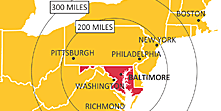In 1629, George Calvert, 1st Lord Baltimore in the Irish House of
Lords, fresh from his failure further north with Newfoundland's
Avalon colony, applied to Charles I for a new royal charter for
what was to become the Province of Maryland. George Calvert died
in April 1632, but a charter for "Maryland Colony" was
granted to his son, C?cilius Calvert, 2nd Lord Baltimore, on June
20, 1632. The new colony was named in honor of Henrietta Maria,
Queen Consort of Charles I.
To try to gain settlers, Maryland used what is known as the headright
system, which originated in Jamestown. The government awarded land
to people who transported colonists to Maryland.
On March 25, 1634, Lord Baltimore sent the first settlers into this
area. Maryland soon became one of the few regions in the British
Empire where Catholics held the highest positions of political authority.
Maryland was also one of the key destinations of tens of thousands
of British convicts. The Maryland Toleration Act of 1649 was one
of the first laws that explicitly dictated religious tolerance,
though toleration was limited to Trinitarian Christians.
Cresap's War, a border conflict between Pennsylvania and Maryland,
fought in the 1730s. Hostilities erupted in 1730 with a series of
violent incidents prompted by disputes over property rights and
law enforcement, and escalated through the first half of the decade,
culminating in the deployment of military forces by Maryland in
1736 and by Pennsylvania in 1737. The armed phase of the conflict
ended in May 1738 with the intervention of King George II, who compelled
the negotiation of a cease-fire. A final settlement was not achieved
until 1767, when the Mason-Dixon Line was recognized as the permanent
boundary between the two colonies.
After Virginia made the practice of Anglicanism mandatory, a large
number of Puritans migrated from Virginia to Maryland, and were
given land for a settlement called Providence. In 1650, the Puritans
revolted against the proprietary government and set up a new government
that outlawed both Catholicism and Anglicanism. In March 1654, the
2nd Lord Baltimore sent an army under the command of Governor William
Stone to put down the revolt. His Roman Catholic army was decisively
defeated by a Puritan army near Annapolis in what was to be known
as the "Battle of the Severn".
The Puritan revolt lasted until 1658. In that year the Calvert family
regained control of the colony and re-enacted the Toleration Act.
However, after England's "Glorious Revolution" of 1688,
when William of Orange and his wife Mary came to the throne and
firmly established the Protestant faith in England, Catholicism
was again outlawed in Maryland, until after the American Revolutionary
War. Many wealthy plantation owners built chapels on their land
so they could practice their Catholicism in relative secrecy. During
the persecution of Maryland Catholics by the Puritan revolutionary
government, all of the original Catholic churches of southern Maryland
were burned down.
St. Mary's City was the largest site of the original Maryland colony,
and was the seat of the colonial government until 1708. In 1708,
the seat of government was moved to Providence, which had been renamed
Annapolis. The city was renamed in honor of Queen Anne in 1694.
Maryland was one of the thirteen colonies that revolted against
British rule in the American Revolution. On February 2, 1781, Maryland
became the 13th state to approve the ratification of the Articles
of Confederation which brought into being the United States as a
united, sovereign and national state. It also became the seventh
state admitted to the U.S. after ratifying the new Constitution.
The following year, in December 1790, Maryland ceded land selected
by President George Washington to the federal government for the
creation of Washington, D.C.. The land was provided from Montgomery
and Prince George's Counties, as well as from Fairfax County and
Alexandria in Virginia. The land provided to Washington, D.C. is
actually "sitting" inside the state of Maryland.
During the War of 1812, the British military attempted to capture
the port of Baltimore, which was protected by Fort McHenry. It was
during this bombardment that the Star Spangled Banner was written
by Francis Scott Key.
As in Virginia and Delaware, numerous planters in Maryland had freed
their slaves in the twenty years after the Revolutionary War. By
1860 Maryland's free black population comprised 49.1% of the total
of African Americans in the state. In addition, Governor Thomas
Holliday Hicks temporarily suspended the legislature, and President
Abraham Lincoln had many of its fire eaters arrested prior to its
reconvening. Many historians contend that there would never have
been sufficient votes for secession.
Of the 115,000 men who joined the militaries during the Civil War,
85,000, or 77%, joined the Union army. To help ensure Maryland's
inclusion in the Union, President Lincoln suspended several civil
liberties, including the writ of habeas corpus, an act deemed illegal
by Maryland native Chief Justice Roger Taney. Lincoln ordered U.S.
troops to place artillery on Federal Hill to threaten the city of
Baltimore, and helped ensure the election of a new pro-union governor
and legislature. Lincoln went so far as to jail certain pro-South
members of the state legislature at Fort McHenry, including the
Mayor of Baltimore, George William Brown. The grandson of Francis
Scott Key was included in those jailed. The constitutionality of
these actions is still debated.
Because Maryland remained in the Union, it was exempted from the
anti-slavery provisions of the Emancipation Proclamation. In 1864
the state held a constitutional convention that culminated in the
passage of a new state constitution. Article 24 of that document
outlawed the practice of slavery. In 1867 the state extended suffrage
to non-white males. |



